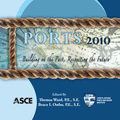Pile Repair and Cathodic Protection of Chem Marine Pier
Publication: Ports 2010: Building on the Past, Respecting the Future
Abstract
This paper presents a case study of the design and construction of a cathodic protection system on a pier in North Charleston, SC while the pier remained fully operational. The Chem Marine Terminal which is jointly operated by Chem Marine and Alcoa in North Charleston, SC was built in 1979, and its primary use is to unload alumina from cargo ships. The pier is a concrete structure that is located in brackish water. The salinity of the water produces a very corrosive environment for reinforced concrete elements, particularly for the 425 prestressed concrete piles. Over the last ten years, two repairs were made to the substructure elements to address corrosion induced damage. The repairs only treated the symptoms, not the cause; therefore, corrosion continued to occur and resulted in additional damage. Subsequently a repair plan that included cathodic protection was proposed to ensure at least a 20 year service life extension. A galvanic cathodic protection system was selected due to its compatibility with repairs, simplicity of design, lower maintenance, and avoidance of hydrogen embrittlement. Although an impressed current system would have afforded more control on the level of protection, hydrogen embrittlement would have been a significant concern and would have required significantly more monitoring effort and maintenance. The cathodic protection system chosen uses a fiberglass jacket with a cathodic protection system built into the jacket. The jacket serves as a form for concrete to be placed around the existing pile. The jacket size can be increased to allow space for reinforcing for a structural repair. The overall design included structural repair designs for different anticipated field conditions. As part of the design criteria, the pier had to remain in operation during the entire construction period. Cargo ships dock at the pier and therefore the pier had be able to withstand the berthing forces. An Unloader on the pier also had to remain operational so that the ships could be unloaded. The forces from both ships and the Unloader are considerable and vastly limited the number of piles that could be repaired at any given time. A challenge with this project was that the design had to include variability to allow for changing field conditions. A limited sample set was obtained for testing during the design phase as many of the piles were encased in jackets and field conditions were expected to vary from the findings during testing. As construction progressed and unsound concrete removed, the amount of corrosion induced damage was greater than anticipated. Therefore, the number of structural repairs increased. This and other problems encountered during construction illustrate the challenges of repair work to existing piers. The 15 month construction period was an integral part of the design since the design team was involved in checking and possibly altering the design to address the unexpected field conditions.
Get full access to this article
View all available purchase options and get full access to this chapter.
Information & Authors
Information
Published In
Copyright
© 2010 American Society of Civil Engineers.
History
Published online: Apr 26, 2012
ASCE Technical Topics:
- Cathodic protection
- Concrete
- Concrete piles
- Construction engineering
- Construction management
- Corrosion
- Deterioration
- Engineering materials (by type)
- Foundations
- Freight transportation
- Geotechnical engineering
- Hydraulic engineering
- Hydraulic structures
- Infrastructure
- Materials characterization
- Materials engineering
- Piers
- Pile foundations
- Piles
- Ports and harbors
- Protective structures
- Structural engineering
- Structures (by type)
- Transportation engineering
- Water and water resources
Authors
Metrics & Citations
Metrics
Citations
Download citation
If you have the appropriate software installed, you can download article citation data to the citation manager of your choice. Simply select your manager software from the list below and click Download.
